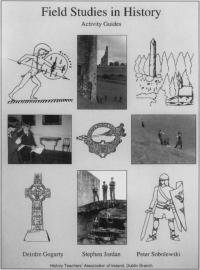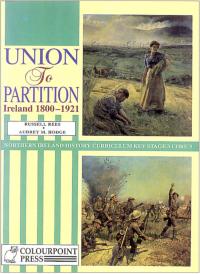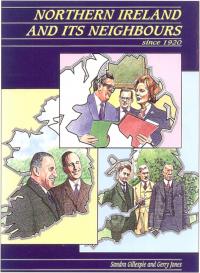New texts for Changing Curriculums
Published in Features, Features, Issue 4 (Winter 1995), Volume 3 South
South
by Maurice Phelan
The new Junior Certificate syllabus, launched with much publicity a few years ago, was to herald a whole new approach to the teaching of history in the South. The emphasis was to be on sending pupils and teachers to the ‘sources’. There was to be a move away from the names, dates, facts type of history to a ‘hands on’ approach. The emphasis was to be on understanding the past rather than memorising the details. Older teachers worried how they were going to cope. They need not have worried. Now that the dust has settled and we have experienced a few of the new Junior Cert. exam papers we can honestly say that it was all much ado about nothing. There has been no great change in what goes on in most classrooms nor have the actual new Junior Cert. exams really encouraged change. The papers may look different. They are much longer, with nice glossy pictures and some documentary extracts. There is however no real incentive to the teacher to adopt an approach based more on sources and field trips. If anything, because of the length of the course the teacher has less time to indulge in these ‘diversions’ than under the old regime.
Having got that off my chest, I welcome the attempt by the Dublin branch of the History Teachers Association of Ireland to actually change what goes on in the classroom and more particularly outside of it. Field Studies in History is a brave attempt to bring the ideals of the new Junior Cert. to fruition. I suspect that it is teachers of Transition Year students (an optional extra year before the senior cycle) who will find it most useful because they are the ones with the time to spare from the ‘tyranny’ of the syllabus. However the tone and language are too obviously directed at Junior Cert. students to be properly suited to the Transition year.
One of the major obstacles and discouragements to teachers interested in bringing their students on field trips, apart from exam pressure, is the lack of material, guides, worksheets, etc., really suited to the early teens. AII teachers know how important it is, if a field trip is to be a real success, that it be thoroughly prepared and that there be some ‘follow through’ which usually means that students get something written down about it. It is remarkable how little students can get out of a field trip if they are not ‘focused’ by a good guide or work sheet or post trip analysis. Of course teachers could always have made their own worksheets and some did, with varying degrees of success. Producing good worksheets is however a time-consuming and specialised process The worksheets contained in this excellent publication are practical, well thought out and ideally suited to the Junior Cert. ability range. They are illustrated, with permission to photocopy, and they can serve as guides as well as worksheets. The book contains all the basic information necessary for organising a good field trip—addresses, phone numbers, admission prices, opening times plus reminders to bring such things as measuring tapes and cameras. It also has a very practical list of reference material. The book contains worksheets on thirteen sites such as Newgrange, Glendalough, the National Museum, medieval Kilkenny—all within reach of Dublin on a day trip. It is produced very specifically for the Dublin area, not surprisingly given its origins in the Blackrock Teachers Centre. This will, no doubt, act as an incentive to others to produce similar material for their own areas.
Maurice Phelan teaches history at Templeogue College, Dublin.
 North
North
by Peter Collins
In line with the continuing review of the history curriculum in Northern Ireland, two further books have recently appeared which will undoubtedly prove of interest to teachers and pupils in key stage three and General Certificate of Secondary Education. Union to Partition by Russell Rees and Audrey Hodge is essentially Colourpoint Press of Omagh responding to changes to key stage three, due for implementation in September 1996. To that extent it is the revision of the earlier excellent Ireland and British Politics 1870-1921 by the same team (see History Ireland Spring 1995). The review of the curriculum has loosened up the core units of study reducing the content, particularly the political content. The cores, renamed ‘compulsory study units’, allow for a broader sweep, now going back to 1800. There are social and economic units such as the rise of the linen and shipbuilding industries and life in rural areas. It also allows the opportunity to do studies of key personalities (Parnell, Countess Markievicz) and key events (Famine, Easter Rising). The usual Colourpoint high standard of illustrations and extracts are there and the text has obviously been written taking into account the comments by teachers on the need for a language level appropriate to the pupil of average ability who represents the majority of potential readers. The activities and questions are both enjoyable and allow for the participation of pupils across the ability range both as individuals and groups. This text is virtually all that the teacher needs to cover this unit and Colourpoint  are to be congratulated for their initiative in getting it out ahead of the competition.
are to be congratulated for their initiative in getting it out ahead of the competition.
Northern Ireland and its neighbours since 1920 was written, like Union to Partition, by two serving teachers Sandra and Gerry Jones who were specially seconded at the behest of the Council for Curriculum, Examinations and Assessment, Northern Ireland to produce a text specifically for the upcoming key stage four (covering the period from partition to the present day). Hodder and Stoughton agreed to publish the work which was designed and illustrated by the Centre for Learning Resources, part of the CCEA. The result has been a blend of economically written and telling text which puts across often complex issues and concepts in a manner which is comprehensible to much of its target age of fifteen to sixteen-year-olds without the danger of losing their brighter peers. Indeed older students and the general reader have commented favourably on the format of this book.
It covers the twentieth century in Ireland opening with the background to partition and continuing with the history of the Irish Free State/Republic and Northern Ireland right up to the present day. As its title suggests it is also the story of the relations between the two parts of this island and also the part played by Britain in Irish affairs. Nor is this book purely about the political side as it deals with social and economic issues and portrays the lives of the people as the century progresses with excellent sections on the hungry thirties and issues like the Outdoor Relief agitation of 1932 in Belfast when Catholic and Protestant workers were briefly on the same side. The authors are particularly to be commended for their clear explication of various attempts at solutions in the current troubles. There is even a section on the options for the future.
The problem, not of the authors’ making, is that key stage four has become stalled and there may be further changes before it finally emerges. Nevertheless it is still an excellent text for the ‘Ireland’ option in GCSE and deserves a wider readership beyond Northern Ireland schools and not just among pupils.
Peter Collins is an associate of the Institute of Irish Studies, Belfast.
















